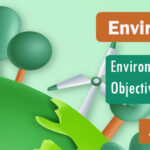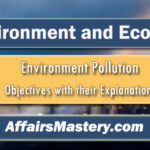Set 2 | Important Environment and Sustainable Development MCQs
Important Environment and Sustainable Development MCQs. Environment and Sustainable Development are pivotal aspects of Environment and Ecology, serving as a cornerstone for success in competitive exams like Civil Services, State exams, SSC, Railways, Banking, and more. Mastering these subjects offers a unique advantage, allowing you to gain invaluable insights into the country’s environmental legacy. With a focus on Environment, Biodiversity, and Ecology, this knowledge not only sharpens your competitive edge but also equips you to excel in these challenging exams.
| MCQs on Environment and Sustainable Development – Objective Questions and Answers |

Q11. Generally, environment can be classified as following categories. Which among the following is NOT a part of such category? (U.P.P.C.S. (Pre) 2020)
[A] Operational Environment
[B] Physical Environment
[C] Cultural Environment
[D] Biological Environment
View Explanation
Correct Answer is A.
- Generally, environment can be classified as physical, cultural and biological environment.
- Physical environment includes landforms, water bodies, climate, soils, rocks, minerals, etc.
- Biological environment includes plants, animals, microorganisms, etc. whereas cultural environment include man-made features such as economical, social and political elements.
Q12. Sustainable development is a matter of inter- generational sensibility in respect of the use of? (U.P.P.C.S.(Pre) 2012)
[A] Natural resources
[B] Material resources
[C] Industrial resources
[D] Social resources
View Explanation
Correct Answer is A.
- The concept of sustainable development was emphasized by the United Nations Conference on Environment and
Development (UNCED), which defined it as ‘Development that meets the need of the present generation without
compromising the ability of the future generation to meet their needs. - Sustainable development is a matter of inter-generational sensibility in respect of the use of natural resources. The main objective of sustainable development is the just and prudent use of natural resources, it’s conservation and proper management.
- This term was explained in the WCED (World Commission on Environment and Development) report of 1987 titled “Our common future“. Sustainable development was fully supported in the Agenda-21 (Rio Declaration) declared in Earth Summit held in 1992.
- Sustainable development was a prominent issue of the Johannesburg Summit 2002. Notably, the United Nations has identified 17 Sustainable Development Goals (SDGs) which have to be realized by 2030. A Sustainable Development Index has also been initiated to measure the progress made by different nations in the direction of achieving these goals.
- Importantly India was ranked 120 out of 165 nations in Sustainable Development Index 2021.
Q13. What is blue carbon? (I.A.S (Pre) 2021)
[A] Carbon captured by oceans and coastal ecosystems
[B] Carbon sequestered in forest biomass and agricultural soils
[C] Carbon contained in petroleum and natural gas
[D] Carbon present in atmosphere
View Explanation
Correct Answer is A.
- Blue carbon is simply the term for carbon captured by the world’s ocean and coastal ecosystems. Sea grasses, mangroves, and salt marshes along our coast “capture and hold” carbon, acting as something called a carbon sink.
- These coastal systems, though much smaller in size than the planet’s forests, sequester this carbon at a much faster rate, and can continue to do so for millions of years.
Q14. ‘Saving energy and other resources for the future without sacrificing people’s comfort in the present’ is the definition of which of the following concepts? (U.P. P.C.S. (Pre) 2018)
[A] Economic growth
[B] Economic development
[C] Sustainable development
[D] Human development
View Explanation
Correct Answer is C.
- The idea of sustainability is the use of resources to meet current needs while preserving their availability for future generations. It includes aspects that are social, economic, and environmental.
- For example, environmental sustainability emphasizes protecting biodiversity, ecosystems, and natural resources like soil, water, and air. This entails promoting renewable energy sources, cutting waste, and minimizing pollution.
- Economic sustainability is the ability of economic activity and growth to persist over the long term without causing social injustice or environmental degradation. It also ensures that economic practices do not deplete resources. It encourages equitable benefit distribution and the prudent use of resources.
- Social sustainability is the preservation and enhancement of justice, equity, and quality of life within communities. It involves having access to social services that support people’s wellbeing across generations, such as healthcare, education, and other services.
- A balance between human development and the state of the planet is essentially what sustainability aims to achieve.
Q15. Which of the following Sustainable Development Goal (SDG) will target the water availability for all and its permanent management up to 2030 in India? (U.P.P.C.S. (Pre) 2019)
[A] SDG – 6
[B] SDG – 7
[C] SDG – 8
[D] SDG – 9
View Explanation
Correct Answer is A.
- The United Nations has identified 17 SDGs (Sustainable Development Goals-SDGs) which have to be realized by
the year 2030. - Among these goals SDG-6 “Clean Water and Sanitation” ensures availability and sustainable management of water and sanitation for all. Today, 2.2 billion people lack access to safely managed drinking water, and more than 4.2 billion people lack safely managed sanitation.
Q16. The Decade of Sustainable Energy for all is the initiative of: (U.P.P.C.S. (Pre) 2017)
[A] United Nations
[B] India
[C] Germany
[D] World Bank
View Explanation
Correct Answer is A.
- Renewable energy is a form of energy that is not the cause of pollution nor has its adverse effect on natural resources.
- Sustainable energy is the seventh goal of the 17 UN Sustainable Development Goals (SDGs), with a call to ensure
access to affordable, reliable, sustainable and modern energy for all by 2030. - The Sustainable Energy for all initiative, acts in support of the 2014-2024 decade of Sustainable Energy for All as declared by the UN General Assembly.
Q17. Which of the following is a Nodal Institution for implementation of Sustainable Development Goals in India? (U.P.P.C.S. (Pre) 2019)
[A] Planning Commission
[B] Disinvestment Commission
[C] NITI Aayog
[D] Finance Commission
View Explanation
Correct Answer is C.
- The Planning Commission was replaced in 2015 by the National Institution for Transforming India, or NITI Aayog, a policy think tank under the Government of India and implement Sustainable Development Goals in India.
| Position | Details |
| Chairperson | Prime Minister of India |
| Vice-Chairperson | Appointed by the Prime Minister (currently held by a senior policy expert) |
| Governing Council | Comprises Chief Ministers of all states, Union Territories with legislatures, and Lieutenant Governors |
| Regional Council | Formed to address specific issues or policies, involving Chief Ministers and/or relevant ministers |
| Full time members | Domain experts in fields like economics, finance, technology, etc. |
| Ex-Officio members | Ministers of key central government departments |
Q18. World Environment Day is celebrated on: (Jharkhand P.C.S. (Pre) 2013, Uttarakhand Lower (Sub.) (Pre) 2010)
[A] 21 March
[B] 23 September
[C] 5 June
[D] 25 May
View Explanation
Correct Answer is C.
- World Environment Day is celebrated annually on June 5th to raise awareness and promote action for environmental protection. Established by the United Nations (UN) in 1972, it has become a global platform for public outreach, with participation from over 150 countries.
- The theme for World Environment Day 2024 is “Land restoration, desertification, and drought resilience”.
Q19. The World Environment Day is celebrated on – (U.P.P.C.S. (Mains) 2014, U.P.P.C.S.(Pre) 2012)
[A] December 1
[B] June 5
[C] November 14
[D] August 15
View Explanation
Correct Answer is B.
- World Environment Day is celebrated annually on June 5th to raise awareness and promote action for environmental protection.
- Host Country: Every year, a different country hosts the global celebration and leads the campaign. The host nation plays a significant role in promoting environmental causes both locally and internationally.
- Goals: Encouraging worldwide awareness and action for the environment.
Q20. The book ‘Silent Spring’ published in 1962 which set the tone for an environmental movement in the world, was written by: (U.P.P.C.S. (Pre) 2020)
[A] Carolyn Merchant
[B] Karl Marx
[C] Rachel Carson
[D] Rajgopalan
View Explanation
Correct Answer is C.
- ‘Silent Spring’ is an environmental science book published in 1962. It was written by an American biologist and ecologist ‘Rachel Carson’.
- The book is widely recognized for having started the modern environmental movement by highlighting the harmful effects of pesticides on the environment, especially DDT (diphenyltrichloroethane).
- Carson described in detail the pollution of soil, water, and air caused by pesticides such as DDT, as well as how these pollutants bioaccumulated in the food chain and eventually caused harm to humans and animals.
Related articles:
- Set 1 | Important Environment and Sustainable Development
- Set 3 | Important Environment and Sustainable Development
- Set 4 | Important Environment and Sustainable Development
- Set 5 | Important Environment and Sustainable Development
- Set 6 | Important Environment and Sustainable Development
- Set 7 | Important Environment and Sustainable Development
- Set 8 | Important Environment and Sustainable Development
- Set 9 | Important Environment and Sustainable Development




